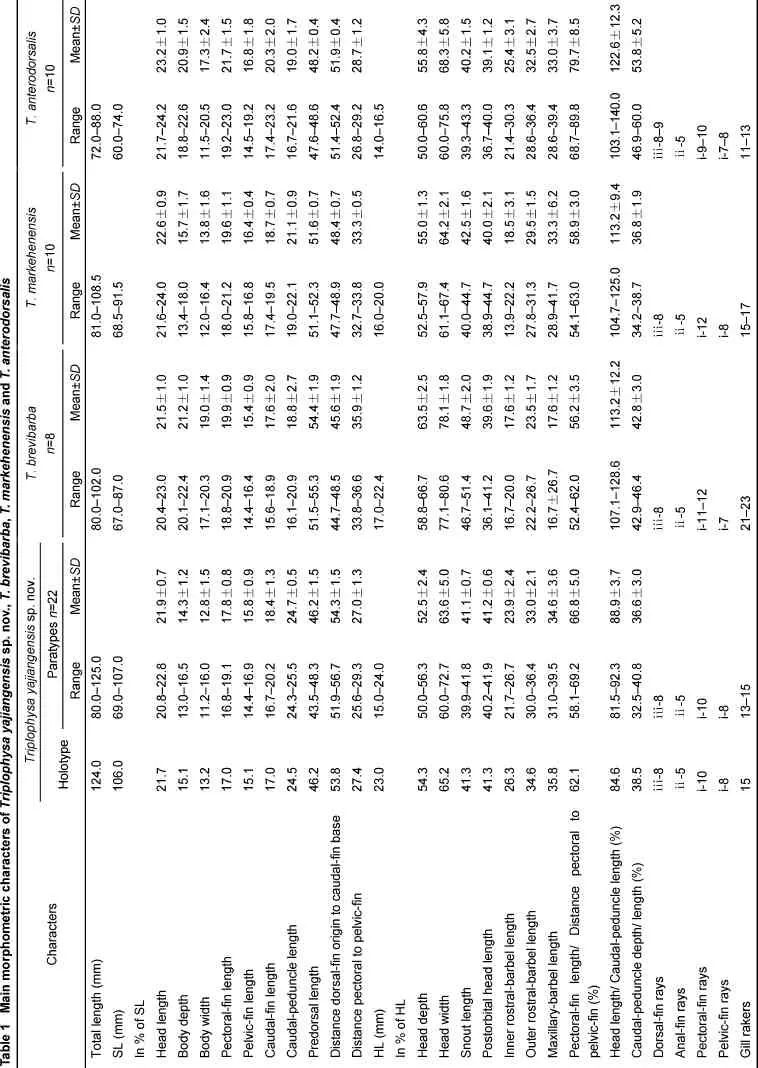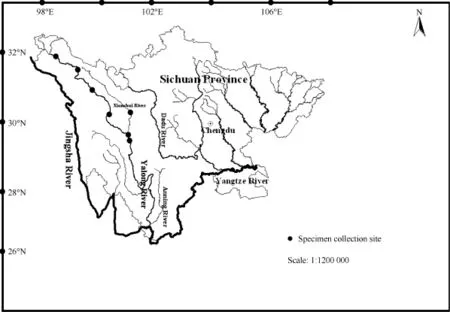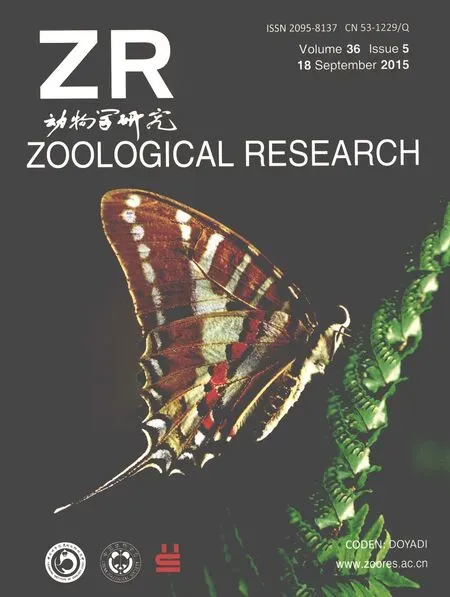A new species of Triplophysa Rendahl (Cypriniformes, Nemacheilidae) from Sichuan Province, China
Si-Li YAN, Zhi-Yu SUN, Yan-Shu GUO,
1College of Life Sciences, China West Normal University, Nanchong Sichuan 637009, China2Sichuan Academy of Forestry, Chengdu Sichuan 610081, China
A new species of Triplophysa Rendahl (Cypriniformes, Nemacheilidae) from Sichuan Province, China
Si-Li YAN1, Zhi-Yu SUN2, Yan-Shu GUO1,*
1College of Life Sciences, China West Normal University, Nanchong Sichuan 637009, China2Sichuan Academy of Forestry, Chengdu Sichuan 610081, China
Triplophysa yajiangensis sp. nov. is described from the upper and middle reaches of the Yalong River, Yangtze Basin, Ganzi Prefecture, Sichuan Province, China. This new species can be distinguished from other congeneric species by the following characters: body surface smooth and scaleless; lateral line complete; caudal peduncle compressed and tapered slightly; lower jaw shovel-shaped; head shorter than caudal peduncle; dorsal-fin origin anterior to pelvic-fin origin and closer to tip of snout than to caudal-fin base, last unbranched ray hard; pelvic-fin reaches or exceeds anus; posterior chamber of gas bladder absent; intestine spiral type with 3-5 winding coils.
Cypriniformes; Nemacheilidae; Triplophysa yajiangensis; New species; Sichuan Province; China
INTRODUCTION
The nemacheilid genus Triplophysa is wide spread on the Qinghai-Tibet plateau and in adjacent areas. In total, there are 126 species of Triplophysa reported, of which 108 occur in China (He et al, 2012). Triplophysa can be distinguished from other nemacheiline genera by the character combination of nostrils close together, posterior wall of the bony capsule of the swim bladder present, and sexual dimorphism in which males have tubercle-bearing, elevated skin on both side of the head, and a thickened tuberculated pad or agglomeration on the dorsal surfaces of the broadened pectoral-fin branched rays (Yang et al, 2011).
The Yalong River is the largest left bank tributary of the Jinsha River of the upper Yangtze River in Sichuan Province, China. From June 2007 to December 2014 we collected 874 specimens of nemacheilid loaches in the Yalong River basin. Comprehensive study of these specimens and detailed comparison with species previously recorded from the Yalong River (Ding, 1993, 1994; Ding & Lai, 1996; He, 2008; He et al, 2012; Wu & Wu, 1992; Zhu, 1989) unveiled a new species, Which is described herein.
MATERIALS AND METHODS
Specimens were captured using a fish trap. The geographic coordinates of the specimen collection site were obtained using a GPS Garmin eTrex handheld device. Specimens were fixed in a 10% formalin solution in the wild, and 5 days were transferred into a 5% formalin solution for long term storage. Measurement methods followed Wu & Wu (1992) and Prokofiev (2007) and were made with digital calipers recorded to its nearest 0.1 mm. Lateral head length is from snout tip to the most posterior point of the opercle.1
Paratypes KIZ2015001222 (Ganzi 201407007) and KIZ2015001223 (Ganzi 201407013) were deposited in the collection of the Kunming Institute of Zoology (KIZ), Chinese Academy of Sciences. Paratypes Yajiang 201009004 and Ganzi 201407003 were deposited in the collection of the Museum of Aquatic Organisms at the Institute of Hydrobiology (IHB), Chinese Academy of Sciences. The examined comparative material, holotype and other paratypes of T. yajiangensis were deposited in the Fish Specimen Room of the College of Life Sciences, China West Normal University, Nanchong, China. Abbreviations used in this paper are: SL, standard length; HL, lateral head length.
RESULTS
Triplophysa yajiangensis sp. nov. (Figure 1–9)
Holotype:Yajiang 201009005, male, 106.0 mm SL; Yalong River, at lime kiln, downstream of Yajiang City (N29°59′51″, E101°00′49″; 2 560 m a.s.l.), Yajiang County, Ganzi Prefecture, Sichuan Province, China; collected by Yan-Shu GUO on September 28, 2010.
Paratypes:22 specimens, 69.0–107.0 mm SL; Yajiang 201009001–004 and Yajiang 201009006 collected by Yan-Shu Guo, September 28, 2010; Yajiang 20140601–02 collected by Yan-Shu GUO and Jun YANG, June 18, 2014; the collection site was the same as that of the holotype. Ganzi 201407001–014, Yalong River, at Dajintan Village (N31°36′36″, E99°59′29″; 3 350 m a.s.l.), Ganzi County, Ganzi Prefecture, Sichuan Province, China; collected by Yan-Shu GUO, Jun YANG and Ming-Hao LUO, on July 17, 2014. Shiqu 20140701, Yalong River, at Gemeng Village (N33°12′56″, E97°57′41″; 4 060 ma.s.l), Shiqu County, Ganzi Prefecture; collected by Yan-Shu GUO, Si-Li YAN and Ming-Hao LUO, July 21, 2014.

Figures 1–9 Triplophysa yajiangensis sp. nov.
Diagnosis:Body surface smooth and scaleless; lateral line complete; caudal peduncle compressed and tapered slightly; lower jaw shovel-shaped; head shorter than caudal peduncle; dorsal-fin origin anterior to pelvic-fin origin and closer to the tip of the snout than to the caudal-fin base, last unbranched ray hard; pelvic-fin reaches or exceeds anus; posterior chamber of gas bladder absent; intestine of spiral type with three to five winding coils.
Description:Morphometric characteristics are provided in Table 1. Body elongate, predorsally columnar. Caudal peduncle compressed and tapered slightly. Body surface smooth and scaleless. Lateral line complete with 83–88 pores.
Snout blunt. Snout length equaled postorbital head length. Anterior and posterior nostril located adjacently and close to anterior rim of orbital. Mouth inferior. Lips thick and furrowed; upper lip without a median incision; lower lip with v-shaped central notch; lower lip surface developed, with shallow furrows. Lower jaw shovel-shaped, with a sharp edge, not covered by lower lip. Three pairs of barbels; inner rostral pair extending to corner of mouth, outer rostral pair extending to a vertica through anterior margin of eye and maxillary pair reaching a vertica through posterior margin of eye.
Dorsal fin with a concave distal margin, last unbranched ray hard. Dorsal-fin origin anterior to pelvic-fin origin and closer to the tip of the snout than to the caudal-fin base. Pectoral-fin tip exceeds the midpoint between pectoral and pelvic-fin origins. Pelvic-fin tip reaches or exceeds the anus. Anal fin has a straight distal margin. Caudal fin deeply emarginate, lower lobe slightly longer than the upper one, the longest branched ray of the lower lobe 1.3 times longer as median rays.
Gas bladder with an anterior chamber fully enclosed in dumbbell-like bony capsule; posterior chamber absent. Stomach u-shaped. Intestine long, and of spiral type with three to five winding coils.
Color pattern in life:Color of the back fawn; lateral side grey green or light fawn; abdomen milky white. Eight dark brown transverse spots on back and five to eight black spots on the side of the body postmedianly. Some individuals have no dark brown transverse spots on the back or black spots on the lateral side. All fins light fawn. Two to three rows of small dark spot on the dorsal fin, three to four rows of small dark spots on the caudal fin, a few small dark spots on the pelvic fin.
Color pattern of preserved specimens:Preserved specimens in 5% formalin solution, the back and lateral side light gray or fawn, abdomen white or yellow white (Figures 2, 3 and 6). Some preserved specimens have eight dark brown transverse spots on back, five to eight black spots on the side of the body postmedianly and 3–4 rows of small dark spots on the caudal fin.
Sexual dimorphism:Upper and lower patch of tubercles in pre- and suborbital areas in males; upper patch is a narrow strip skewed upwards located sub-antero-orbitally; lower patch is triangle-shaped and is located at the base of the maxillary barbel in front of the operculum. In males, the first to sixth branched pectoral-fin rays possess a patch of tubercles dorsally; pectoral-fin is shorter and wider than in females (Figure 6).
Distribution:Currently known to be distributed in the upper and middle reaches of the Yalong River, Yangtze basin in Sichuan Province, China (Figure 9).
Ecology:Inhabits areas close to river banks with slow water flow; bottom composed of gravel; submerged waterweeds are absent (Figure 10). Algae and aquatic invertebrates were found in the stomachs of eight dissected specimens.
Etymology:The specific epithet is derived from the city of Yajiang located at Yalong River, from where the holotype was collected.
DISCUSSION


Figure 10 Map showing the distribution of Triplophysa yajiangensis sp. nov.

Figure 11 Habitat of Triplophysa yajiangensis sp. nov.
Triplophysa yajiangensis can be distinguished from T. orientalis, T. obscura, T. scleroptera, T. pseudoscleroptera and T. xichangensis by lower jaw shovel-shaped vs. spoon-shaped and posterior chamber of the gas bladder degenerated vs. developed (Ding, 1994; Wu & Wu, 1992; Zhu, 1989; Zhu & Wu, 1981).
Triplophysa yajiangensis can be distinguished from T. robusta, T. angeli, T. leptosoma, T. pseudostenura, T. daqiaoensis, T. brevicauda, T. bleekeri, T. xiqiensis and T. pappenheimi by lower jaw shovel-shaped vs. spoon-shaped and intestine winding spiral type with three to five coils vs. a zigzag loop (Ding, 1993, 1994; Ding & Lai, 1996; Guo et al, 2012; He et al, 2012; Wu & Wu, 1992; Zhu, 1989).
In Triplophysa stoliczkae and T. crassilabris, the lower lips are divided into two leaves, thin and wide, centrally continuous; the dorsal-fin origin is nearer to the caudal fin base than to the tip of the snout, the last unbranched dorsal-fin ray is soft; the intestine is of the winding spiral type with 4–7 coils. In Triplophysa yajiangensis the lower lip has a v-shaped notch in the middle; the last unbranched dorsal-fin ray is hard; dorsal-fin origin is nearer to the tip of the snout than to the caudal fin base and the intestine is of the winding spiral type with three to five coils (Ding, 1994; Wu & Wu, 1992; Zhu, 1989).
Triplophysa yajiangensis, T. stenura and T. lixianensis share a shovel-shaped lower jaw, but the caudal peduncle of T. stenura and T. lixianensis is round and tapers obviously (Zhu, 1989; Wu & Wu, 1992; Ding, 1994; He et al, 2008).
Triplophysa yajiangensis and T. nujiangensa share a shovelshaped lower jaw and the intestine is of the winding spiral type with three coils. However T. yajiangensis can be distinguished from T. nujiangensa by predorsal length 43.5%–48.3% of SL vs. 71.1%–77.2%, last unbranched dorsal-fin ray hard vs. soft and pelvic-fin tip reaching anus vs. not reaching anus (Chen et al, 2004).
Triplophysa yajiangensis can be distinguished from T. tanggulaensis by predorsal length/SL 43.5–48.3 vs 47.0–55.0 and head shorter than caudal peduncle vs. longer than caudal peduncle (Zhu, 1989).
Triplophysa yajiangensis can be distinguished from T. brevibarba (and its junior synonym T. ding Prokoview, 2010) by head length 81.5%–92.3% of caudal-peduncle length vs.107.1%–128.6%, dorsal-fin origin nearer to the tip of the snout than to the caudal-fin base vs. vice versa and rakers on the inner side of the first branchial arch 13–15 vs. 21–23 (Table 1, Figures 12–14) (Ding, 1993; Prokofiev, 2010).
Triplophysa yajiangensis closely resembles T. markehenensis, but can be distinguished from by the posterior chamber of the gas bladder being absent vs. developed (diameter 4–5 mm), head length 81.5%–92.3% of caudal-peduncle length vs. 104.7%–125.0%, and dorsal-fin origin nearer to the tip of the snout than to the caudal fin base vs. vice versa (Table 1, Figures 15–17) (Zhu & Wu, 1981; Zhu, 1989; Wu & Wu, 1992).
Triplophysa yajiangensis can be distinguished from T. anterorsalis by head length 81.5%–92.3% of caudal-peduncle length vs. 103.1%–140.0%, last unbranched dorsal-fin ray hard vs. soft, caudal-fin deeply emarginate vs. emarginate and intestine of spiral type with three to five winding coils vs. a zigzag loop (Table 1, Figures 18–20) (Zhu, 1989).
Distribution of nemacheilid loaches in the Yalong River basin is provided in Table 2.

Table 2 Distribution of Triplophysa in the Yalong River basin

12–14: T. brevibarba (12: Mianning201112079, 92.5 mm SL, male, lateral view, life coloration; 13: Ventral view of head; 14: Intestines, ventral view); 15–17: T. markehenensis (15: Banma201108021, 83.2 mm SL, male, lateral view, life coloration; 16: Ventral view of head; 17: Intestines, ventral view); 18–20: T. anterodorsalis (18: Huidong201112066, 69.2 mm SL, male, lateral view, life coloration; 19: Ventral view of head; 20: Intestines, ventral view)
A key to the species known to occur in the Yalong River is as follows:
1a. Lower jaw is shovel-shaped...............................................2
1b. Lower jaw is spoon-shaped...............................................5
2a. Caudal peduncle round........................Triplophysa stenura
2b. Caudal peduncle not round................................................3
3a. Last unbranched dorsal-fin ray hard; dorsal-fin origin is nearer to tip of snout than to caudal fin base; intestine winding spiral type three coils.......T. yajiangensis sp. nov.
3b. Last unbranched dorsal-fin ray soft; dorsal-fin origin is nearer to caudal fin base than to tip of snout. .................4
4a. Lower lip is divided into two leaves, thin and wide, centrally continuous; intestine helix with four to seven coils..................................................................T. stoliczkae
4b. Lower lip has a v-shaped notch, lower lip surface is developed and has furrows; intestine helix with three coils................................................................T. brevibarba
5a. Posterior portion of gas bladder developed.....................6
5b. Poster portion of gas bladder greatly degenerated or absent................................................................................7
6a. Posterior portion of gas bladder constricted medially; pelvic-fin tip reaches or exceeds the anus......T. orientalis
6b. Posterior portion of gas bladder without medial constriction, appearing cylindrical; pelvic-fin tip does not reach the anus.............................................................T. xichangensis
7a. Caudal peduncle tapers towards caudal fin......................8
7b. Caudal peduncle depth to caudal fin direction unchanged ...........................................................................................9
8a. Pelvic-fin origin is anterior to dorsal-fin origin; pelvic-fin tip does not reach the anus; caudal fin forkedT. pseudostenura
8b. Dorsal-fin origin is anterior to pelvic-fin origin or is relative; pelvic-fin tip reaches or exceeds the anus; caudal fin emarginated.....................................................T. leptosoma
9a. Pelvic-fin origin is anterior to dorsal-fin origin; pelvic-fin tip does not reach the anus..............................T. daqiaoensis
9b. Dorsal-fin origin is anterior to pelvic-fin origin; pelvic-fin tip reaches the anus..............................................................10
10a. Head length is equal to the caudal-peduncle length......... .......................................................................T. brevicauda
10b. Head length is longer than the caudal-peduncle length... .......................................................................... T. bleekeri Comparative materials
T.stoliczkae.Shiqu YalongJiang 201106001–023, 201407016–029, Yalong River basin, Shiqu County, Ganzi Prefecture, Sichuan Province, China.
T.orientalis.Shiqu YalongJiang 201106031–039, 201108047–055, Yalong River basin, Shiqu County.
T.leptosoma.Shiqu YalongJiang 201106040–59, 201407030–055, Yalong River basin, Shiqu County.
T. pseudostenura.Ganzi 68051–052, 201407013–016, Yalong River, Ganzi County, Ganzi Prefecture.
T. daqiaoensis.Mianning 201112001–036, 201406047–066, Upper Anning River, Mianning County, Liangshan Prefecture, Sichuan Province; Shiqu JinshaJiang 201207001–038, Jinsha River basin, Shiqu County.
T. brevicauda.Litang 201009001–026, 201406001–033, Upper Litang River, Litang County, Ganzi Prefecture; Deqin 201008042–043, Lancang River, Deqin County, Yunnan Province, China.
T. xichangensis.Mianning 201112048–56, 201401001–026, Upper Anning River, Mianning County.
T. brevibarba.Mianning 199705001–008, 201112070–087, Anning River, Mianning County.
T. stenura.Yanyuan 201412010-051, Yantang River, Yanyuan County, Liangshan Prefecture; Shiqu JinshaJiang 201207039-082, 201407001-004, Jinsha River basin, Shiqu County.
T. bleekeri.Mianning 201112037–069, 201406001–046, Anning River, Mianning County; Yaan 2008010001–016, Qingyi River basin, Yaan City, Sichuan Provinc.
T. markehenensis.Banma 201108001–026, Maerke River, Banma County, Qinghai Province, China; Aba 201108001–019, Maerke River, Aba County, Aba Prefecture, Sichuan Province.
T. anterodorsalisHuidong 201401001–026, Jinsha River basin, Huidong County, Liangshan Prefecture.
Chen XY, Cui GH, Yang JX. 2004. A new fish species of genus Triplophysa (Balitoridae) from Nu Jiang, Yunnan, China. Zoological Research, 25(6): 504–509. (in Chinese)
Ding RH. 1993. Two new species of the Genus Triplophysa from western Sichuan (Cypriniformes: Cobitidae). Acta Zootaxonomica Sinica, 18(2): 247–251. (in Chinese)
Ding RH. 1994. The Fishes of Sichuan. Chengdu: Sichuan Science and Technology Press, 63–95. (in Chinese)
Ding RH, Lai Q. 1996. A new species of Triplophysa from Sichuan.Acta Zootaxonomica Sinica, 21(3): 374–376.(in Chinese)
Guo YS, Sun ZY, Fu JR, Liu SY, Guo ZW, Yang J. 2012. Found once more and annotation on the type locality of Triplophysa angeli. Acta Zootaxonomica Sinica, 37(4): 912–914. (in Chinese)
He CL, Song ZB, Zhang E. 2008. Triplophysa lixianensis, a new nemacheiline loach species (Pisces: Balitoridae) from the upper Yangtze River drainage in Sichuan Province, South China. Zootaxa, 1739: 41–52.
He CL, Zhang E, Song ZB. 2012. Triplophysa pseudostenura, a new nemacheiline loach (Cypriniformes: Balitoridae) from the Yalong River of China. Zootaxa, 3586: 272–280.
Prokofiev AM. 2007. Materials towards the revision of the genus Triplophysa Rendahl, 1933 (Cobitoidea: Balitoridae: Nemacheilinae): a revision of nominal taxa of Herzenstein (1888) described within the species “Nemachilus” stoliczkae and “N.” dorsonotatus, with the description of the new species T. scapanognathasp. nova. Journal of Ichthyology, 47(1): 1–20.
Prokofiev AM. 2010. Morphological classification of loaches (Nemacheilinae). Journal of Ichthyology, 50(10): 827–913.
Wu YF, Wu CZ. 1992.The Fishes of The Qinghai-Xizang Plateau. Chengdu: Sichuan Science and Technology Press, 52, 149–264. (in Chinese)
Yang J, Wu TJ, Lan JH. 2011. A new blind loach species, Triplophysa huanjiangensis (Teleostei: Balitoridae), from Guangxi, China. Zoological Research, 32(5): 566–571.
Zhu SQ, Wu YF. 1981. A new species and a new subspecies of loaches of the genus Nemachilus from Qinghai Province. Acta Zootaxonomica Sinica, 6(2 ): 221–224. (in Chinese)
Zhu SQ. 1989. The Loaches of the Subfamily Nemachceilinae in China (Cypriniformes, Cobitidae). Nanjing: Jiangsu Science and Technology Press, 69–129. (in Chinese)
Received: 14 May 2015; Accepted: 31 July 2015
Foundation items: This study was support by the Open Research Fund of Laboratory of Sichuan Academy of Forestry (2015016)
*Corresponding author, E-mail: 850316857@qq.com
10.13918/j.issn.2095-8137.2015.5.299
- Zoological Research的其它文章
- Catalog of insect type specimens preserved at the Kunming Institute of Zoology, Chinese Academy of Science with corrections of some specimens
- Kunming Institute of Zoology, Chinese Academy of Sciences, acquires GLP certification from the CFDA
- Establishment and characterization of an astroglial cell line derived from the brain of half-smooth tongue sole (Cynoglossus semilaevis)
- Longitudinal analysis reveals characteristically high proportions of bacterial vaginosis-associated bacteria and temporal variability of vaginal microbiota in northern pig-tailed macaques (Macaca leonina)
- Cannot see you but can hear you: vocal identity recognition in microbats
- How to write an appealing scientific story

